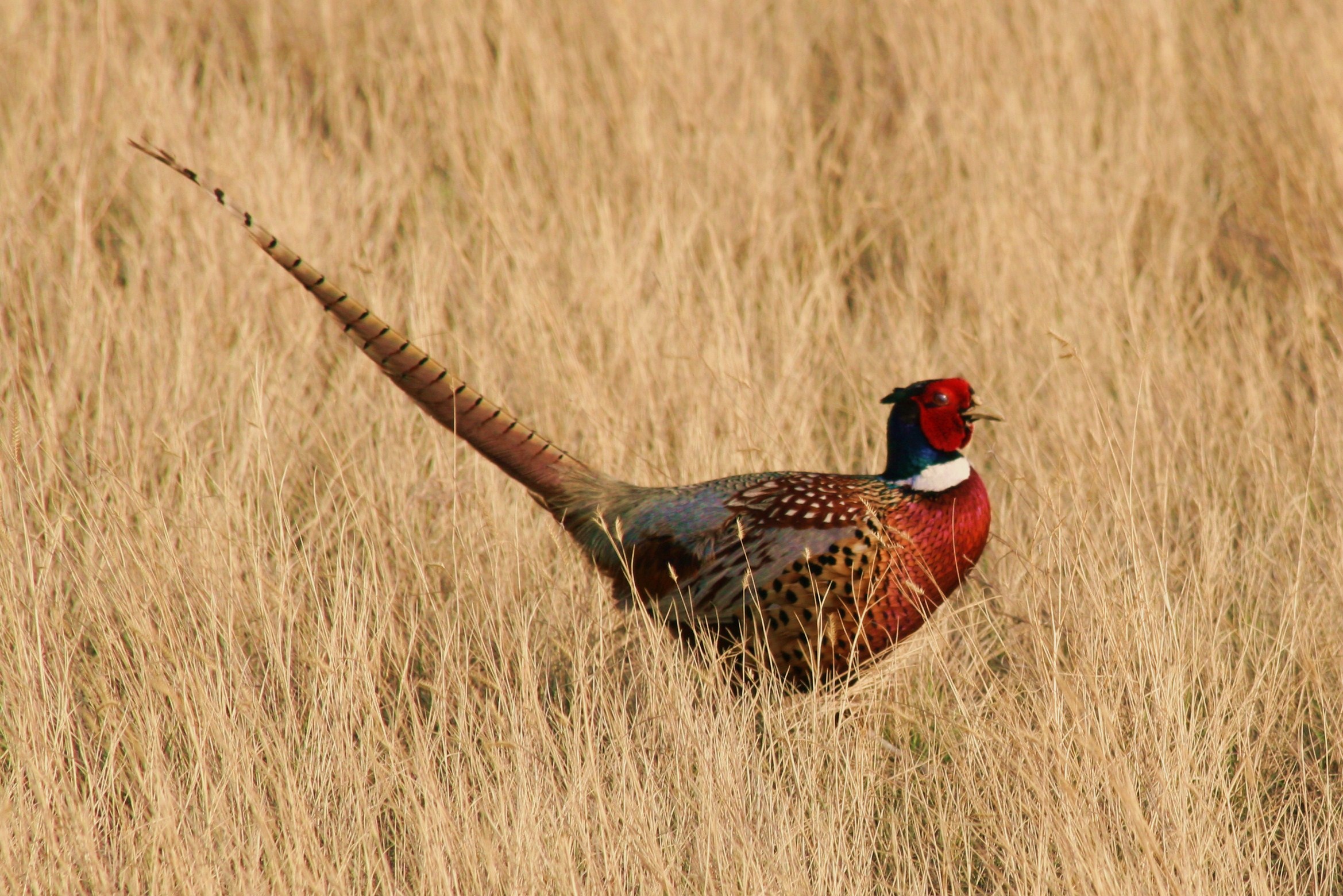A couple of years ago, in early spring, I heard a cock pheasant crowing as he walked across the driveway on Owl Acres. He was probably on his way to find some mates. His call was a harsh squawk which the ladies apparently find attractive. If he was lucky, he put together an entire harem of females, from two to eighteen in all, to mate with and pass along his genes. His harem would last through the breeding season and then dissolve in late summer or early fall.
The ring-neck pheasants, (Phasianus colchicus) are native to Eurasia. They range from the Caspian Sea to China and Korea. They have been introduced to Europe, Hawaii, Australia, and most other parts of the world, including North America. They were intentionally introduced into the United States in 1881 as game birds. By 1900, a game breeder named William Benton of Cedar Falls, Iowa had some two thousand birds. A major windstorm destroyed the pens, accidentally releasing all two thousand birds into the wild. This event formed the initial stock of ring-neck pheasants in Iowa. From the beginning, pheasants were a popular game bird. The Department of Natural Resources began stocking additional pheasants in Iowa in 1910, and by 1930, all regions of the state were receiving pheasant stock for hunting. Today the DNR estimates a population of from four to six million pheasants in Iowa.
The plumage of male ring-neck pheasants is a showy mix of copper, brown, gray and black on the body with iridescent bright green on the neck and bright red wattles on the head. By the time they’re a year old, young males also develop the eponymous white ring around their necks. Females, as so often happens in the bird world, are quite drab in comparison. They’re an unremarkable light brown with black flecks on their feathers. Males weigh up to three pounds with females a bit smaller.
Pheasants prefer to live in open grasslands and fields with some brush and trees available for cover. They are omnivores, eating insects and small invertebrates along with seeds, berries and plant material. Grain is a major source of food for them, and is readily found in the fields around Owl Acres. Pheasants don’t migrate. They form flocks in the fall and harvest weed seeds and berries along with the grain left behind in the fields.
Beginning in early March, male pheasants start crowing, fighting and establishing their breeding territories for the year. Because one male will claim up to 18 females for a breeding season, the number of males who actually end up mating is far less than the number available. This cock of the walk, however, does nothing to help all those mothers to raise his offspring. While he’s busy giving himself a dust bath, luxuriating in his parasite-free bliss, she’s incubating up to a dozen eggs in a shallow nest lined with some grass or leaves that she scratched out under the cover of dense vegetation. Incubation takes twice as long as for her songbird sisters, but when the chicks hatch, they are covered in down and they can walk and see. They immediately start following their mother to food sources and chow down on all the insects they can find. They’ll start in on plants and seeds as their need for protein decreases.
Although male pheasants may seem to have a good thing going with their many wives and little responsibility, in reality, they lead a very dangerous life. While they can live from 11 to 18 years in captivity, in the wild the average is three years, with an annual mortality rate of 70%. Nests and chicks are vulnerable to foxes, weasels, snakes, owls, hawks, coyotes and other predators. And the main predator, of course, is hunters.
Iowa’s hunting season begins the last Saturday in October and runs through January 10. Hunters are only allowed to take the cocks, and in the first three weeks of the season, some 180,000 hunters take to the fields to bag between 1.2 and 1.4 million birds.
I remember eating pheasant when I was a kid. My dad didn’t hunt, but some of his friends did, and he would give them permission to hunt on our land. In exchange, they would give us a bird or two to eat. I haven’t heard any pheasants crowing this year, but the season has just begun.
Photo from Wikimedia.org by: USFWS Mountain-Prairie (public domain). A showy, chicken-size bird struts in a tallgrass prairie. Ring-neck pheasant has a ring of white feathers encircling his neck. His long, tapering tail feathers are half again the length of his stout body.

1 comment
Great information, Karen. Interesting to see how pheasants spread across Iowa and the midwest. Thanks for sharing this. – Joe